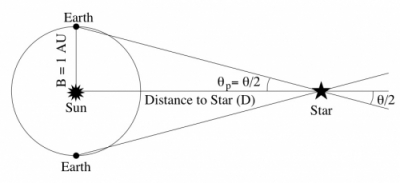
The stars lie millions of times farther away than the sun, so astronomers have to use different techniques to establish their distance. The most important is the method of Parallax, which involves measuring the angle of the movement of a star between two points and relating it to the Earth’s orbit.
A simple experiment illustrates the method. Hold a finger in front of your face; in relation to the background. Now close that eye and open the other. The finger seems to have moved. The nearer the finger is to your face, the greater distance it seems to move.
In astronomy, the finger is the nearby star whose distance is being measured. Astronomers observe its position relative to very distant stars, looking at it from two different positions in the Earth’s orbit. By measuring the angle of the stars apparent movement between these two positions, also known as the Parallax angle, and knowing the diameter of the Earth’s orbit, astronomers can calculate the distance.
The Parallax angle is measured in arc seconds. One arc second is 1/3600 of a degree in the sky, or roughly 1/2000 the apparent size of the moon. The distance to a star in light-years is 3.26 divided by the Parallax angle. The result is given in parsecs, which is the unit of distance that corresponds to a parallax of one second of arc, or 3.26 light years. Using this method, astronomers have found the distance to hundreds of the nearest stars. For example, the nearest star to the sun is a faint one called Proxima Centuari, which lies 4.22 light years away or 1.2 parsecs. The brightest star in the sky, Sirius, is 8.6 light years away, or 2.64 parsecs.
Picture Credit : Google

